Episode two
The episode opens with Crudelli giving a female cab driver some self-defence tips, such as how to disarm somebody who had pulled a knife on her. Next we see Tanaka and his daughter Midori. While she shoots arrows at him he slices through them with his sword. Tanaka then attempt to disarm an opponent wielding a sword using only his hands. Back in Manila, Ernesto Presas explains more about Kombatan, a Filipino fighting system. Presas demonstrates the skill of being able to fight an opponent while blindfolded.
He even fights on opponent while carrying on a conversation with Crudelli, not even looking in his opponents direction. He also claims to have an amulet, which prevents him from becoming tired. A short section then follows showing Crudelli demonstrating some qi work with employees of Cardiff Auction Rooms. At Shasui Falls, in Japan, Crudelli is introduced to the concept of Satki (described as "telepathy." The actual term, however, is "sakki," and it actually means "killing intent/qi" or "a thirst for blood"). Aoki explains that one can learn to detect Satki, and by doing so can learn to predict an opponent's moves, thus acting before the opponent has chance to strike. Aoki explains that to develop Satki, a person meditates in standing in a heavy waterfall – something which forces the temperature of the body to fall considerably. After ten minutes in the ice cold waterfall, the person's mind and consciousness opens enough to detect Satki. Aoki also describes what he called vacuum energy, which he uses on his opponent when Satki has been detected. Once Satki is detected Aoki uses vacuum energy in two ways, either to stop his opponent or send them running in the other direction.
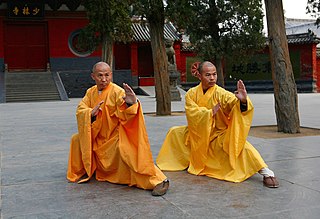
Neijia is the collective name for the internal Chinese martial arts. It relates to those martial arts occupied with spiritual, mental or qi-related aspects, as opposed to an "external" approach focused on physiological aspects. The distinction dates to the 17th century, but its modern application is due to publications by Sun Lutang, dating to the period of 1915 to 1928. Neijin is developed by using neigong or "internal changes", contrasted with waigong or "external exercises".

Tai chi is an ancient Chinese martial art. Initially developed for combat and self-defense, for most practitioners it has evolved into a sport and form of exercise. As an exercise, tai chi is performed as gentle, low-impact movement in which practitioners perform a series of deliberate, flowing motions while focusing on deep, slow breaths. Often referred to as "meditation in motion," tai chi aims to concentrate and balance the body's qi, providing benefits to mental and physical health.
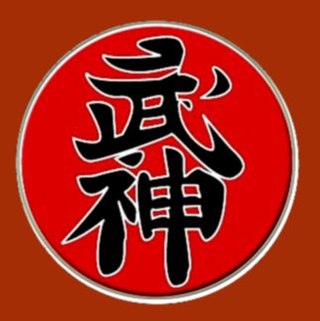
The Bujinkan is an international martial arts organization based in Japan and headed by Masaaki Hatsumi. The combat system taught by this organization comprises nine separate ryūha, or schools, which are collectively referred to as Bujinkan Budō Taijutsu. The Bujinkan is most commonly associated with ninjutsu. However, Masaaki Hatsumi uses the term Budo as he says the ryūha are descended from historical samurai schools that teach samurai martial tactics and ninjutsu schools that teach ninja tactics.
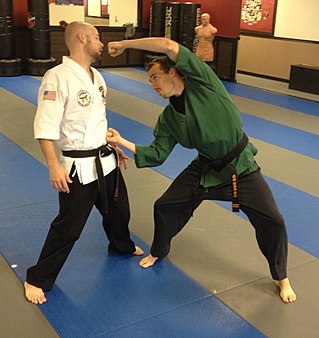
Kenpō is the name of several martial arts. This term is often informally transliterated as "kempo", as a result of applying Traditional Hepburn romanization, but failing to use a macron to indicate the long vowel. The word Kenpō translates to "Fist Method" : "ken" meaning "fist" and "po" meaning "method/law". The generic nature of the term combined with its widespread, cross-cultural adoption in the martial arts community has led to many divergent definitions.

Pushing hands, Push hands or tuishou is a two-person training routine practiced in internal Chinese martial arts such as baguazhang, xingyiquan, tai chi, and yiquan. It is also played as an international sport akin to judo, sumo and wrestling, such as in Taiwan, where the biannual Tai Chi World Cup is held.

Chinese martial arts, commonly referred to with umbrella terms kung fu, kuoshu or wushu, are multiple fighting styles that have developed over the centuries in Greater China. These fighting styles are often classified according to common traits, identified as "families" of martial arts. Examples of such traits include Shaolinquan (少林拳) physical exercises involving All Other Animals (五形) mimicry or training methods inspired by Old Chinese philosophies, religions and legends. Styles that focus on qi manipulation are called internal, while others that concentrate on improving muscle and cardiovascular fitness are called external. Geographical associations, as in northern and southern, is another popular classification method.
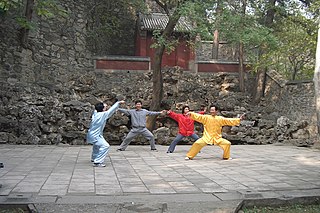
The Chen-style tai chi is a Northern Chinese martial art and the original form of tai chi. Chen-style is characterized by silk reeling, alternating fast and slow motions, and bursts of power.

Yiquan, also known as dachengquan, is a Chinese martial art founded by the xingyiquan master Wang Xiangzhai. Yì (意) means Intent, quán (拳) means boxing.
Neigong, also spelled nei kung, neigung, or nae gong, refers to a series of internal changes that a practitioner goes through when following the path to Dao, and these changes may be achieved through practices including qigong or tai chi. Neigong is also associated with xingyi quan.

Fujian White Crane, also known as White Crane Style is a Southern Chinese martial art that originated in Yongchun County, Fujian (福建) province. According to oral tradition, the style was developed by Fang Qiniang, a female martial artist. It is associated with traditional fighting techniques, including long range, but is most similar to close-quarter or hand-to-hand combat. It is most recognizable by the way the fighter imitates a bird's pecking or flapping of wings. While some white crane styles make use of traditional weapons, others have discontinued the use of weaponry.
The Liu Seong System is one of the many styles of Kuntao, which are hybrid martial arts systems derived from the cultures of Chinese Indonesia. The Liu Seong system was brought to America, from Indonesia, by Willem A. Reeders (1917-1990).
The touch of death is any martial arts technique reputed to kill using seemingly less than lethal force targeted at specific areas of the body.
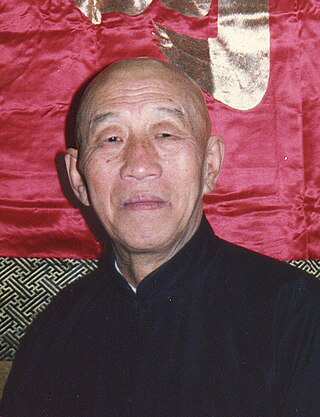
Kuo Lien-ying was one of the most distinguished and revered martial artists of the twentieth century. He brought the Guang Ping Yang tai chi to the United States.

Guang Ping Yang tai chi is a tai chi style descended from Yang-style tai chi. It claims to combine all the positive aspects of Yang-style with qualities that added strength and versatility. Its stances are lower and wider than Yang-style, but not as pronounced as Chen-style. Guang Ping is also distinguished by as little as a 51%/49% weight difference between leading and trailing foot in certain moves. A stronger, more balanced foundation gives the student more power and greater flexibility. Guang Ping Yang tai chi also combines Xingyiquan and Baguazhang energies, which can be seen in Guang Ping's spiral force energy and projecting force energy theories. It has become known as the "lost" Yang-style tai chi form.
Chu Guiting was a prolific martial artist who studied under the famous local masters, Jiang Yuhe, Yu Bingzhong, and Chen Delu, and went on to influence many different Chinese martial arts schools through his teaching.
Togakure-ryū (戸隠流) is a historical tradition of ninjutsu known as the "School of the Hidden Door", allegedly founded during the Oho period (1161–1162) by Daisuke Nishina (仁科大助), who learned his original fighting techniques from a Chinese monk named Kain Dōshi. However, the history and early lineage of Togakure-ryū may be impossible to verify due to the antiquity of the time period and its claimed historicity has been disputed by Watatani Kiyoshi, writer for the Bugei Ryūha Daijiten. After Togakure, the title of Sōke was recorded by Toda Shinryuken Masamitsu to have been passed down through other practitioners that kept the style secret from the outside world.
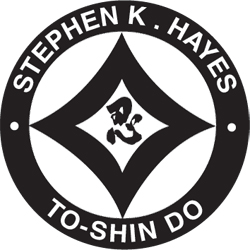
To-Shin Do is a martial art founded by Black Belt Hall of Fame instructor Stephen K. Hayes in 1997. It is a modernized version of ninjutsu, and differs from the traditional form taught by Masaaki Hatsumi’s Bujinkan organization. Instruction focuses on threats found in contemporary western society. In addition to hand-to-hand combat skills, students are exposed to: methods for survival in hostile environments, security protection for dignitaries, how to instruct classes and run a school, classical Japanese weapons, meditation mind science, and health restoration yoga. The headquarters school (hombu) is located in Dayton, Ohio, USA.

Yang Luchan, also known as Yang Fukui (1799–1872), was an influential Chinese practitioner and teacher of the internal style tai chi martial art. He is known as the founder of Yang-style tai chi, the most popular and widely practised tai chi style in the world today.

Gene Chen was a Chinese American martial artist. Though he was knowledgeable in many Chinese martial arts, he was a master in Chu Gar Southern Praying Mantis and Chen-style tai chi.
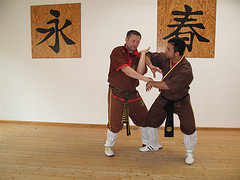
Weng Chun Kung Fu is a Southern-style Chinese Martial Art.













